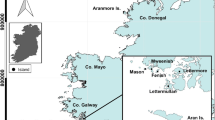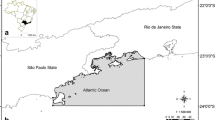Abstract
Ireland has a long history of seaweed utilisation, with accounts of its use as a food dating to at least the twelfth century. Arramara Teoranta (literally “Seagoods Ltd.”) was established by the Irish Government in the late 1940s to continue the long tradition of sustainable seaweed harvesting in the west of Ireland, which began with kelp ash production from kelp kilns around 1700 and which continued sporadically until 1948. Initially, Arramara purchased dried sea rods (Laminaria hyperborea) and kelp fronds (mostly Saccharina latissima) and these were exported for alginate production in Scotland. Kelps were gradually replaced by Ascophyllum nodosum, a perennial wrack found in the intertidal of the North Atlantic and which is particularly common on sheltered shores in the west of Ireland. This wrack has been cut sustainably by hand in Ireland since at least the late 1940s. Figures for annual production from the main purchaser, Arramara, show that 2,000–7,000 dry weight tons (about 8,000–28,000 wet tons) have been cut in Ireland each year from 1964 to date. Whilst exports for alginate production ceased in 2009, 5,000–6,000 dry weight tons are currently being produced for the animal feed, horticulture, aquaculture, and cosmetics markets.








Similar content being viewed by others
Notes
George Henry Kinahan (1829–1908) was Senior Geologist with the Geological Survey of Ireland.
A number of Acts of the Oireachtas [Irish Parliament] relate to the share ownership of this company: Alginate Industries (Ireland) Limited (Acquisition of Shares) Act, 1949 and 1954 and Arramara Teoranta (Acquisition Of Shares) Act, 2002, each of which are available at http://www.acts.ie
References
Baardseth E (1949) Regrowth of Ascophyllum nodosum after harvesting. Report to Institute for Industrial Research and Standards, Dublin. Typewritten manuscript at NUI Galway
Baardseth E (1955) Regrowth of Ascophyllum nodosum after harvesting. Institute for Industrial Research and Standards, Dublin
Boaden PJS, Dring MJ (1980) A quantitative evaluation of the effect of Ascophyllum harvesting on the littoral ecosystem. Helgol Wiss Meeres 33:700–710
Clow A, Clow NL (1947) The natural and economic history of kelp. Ann Sci 5:297–317
Cullinane JP (1984) A quantitative survey of the harvestable intertidal seaweed on the west coast of Ireland. Proc Intn Seaweed Symp 11:338–341, Hydrobiologia 116/117
Guiry MD (1997) Went Memorial Lecture 1996. Research and development of a sustainable Irish seaweed industry. Occ Paps Ir Sci Tech R Dubl Soc No 14:1–11
Guiry MD (2012) A catalogue of Irish seaweeds. A.R.G. Gantner, Ruggell
Guiry MD, Blunden G (1981) The commercial collection and utilization of seaweed in Ireland. Proc Int Seaweed Symp 10:675–680
Guiry MD, Guiry GM (2013) AlgaeBase. World-wide electronic publication, NUI, Galway. http://www.algaebase.org. Accessed 18 February 2013
Guiry MD, Hession CC (1998) The seaweed resources of Ireland. In: Critchley AT, Ohno M (eds) Seaweed resources of the world. Japan International Cooperation Agency, Yokosuka, pp 210–216
Harper D (1974) Kelp burning in the Glens. J Glens Antrim Hist Soc 2:19–24
Hession CC, Guiry MD, McGarvey S, Joyce D (1998) Mapping and assessment of the seaweed resources (Ascophyllum nodosum, Laminaria spp.) off the west coast of Ireland. Mar Res Ser 5:1–74
Jensen A (1998) The seaweed resources of Norway. In: Critchley AT, Ohno M, Largo DB, Gillespie RD (eds) Seaweed resources of the world. Japan International Cooperation Agency, Yokosuka, pp 200–209
Kelly L, Collier L, Costello MJ, Diver M, McGarvey S, Kraan S, Morrisey J, Guiry MD (2001) Impact assessment of hand and mechanical harvesting of Ascophyllum nodosum on regeneration and biodiversity. Mar Res Ser 19:1–51
Kinahan GH (1869) The seaweeds of Yar-Connaught and their uses Ql. J Sci 6:331–341
Kirwan R (1789) Experiments on the alkaline substances used in bleaching, and the colouring matter of linen-yarn. Trans R Ir Acad 3:3–47
Mac Con Iomaire S (1938) Cladaigh Chonamara [Shores of Connemara]. Oifig an tSoláthair [Stationery Office], Baile Átha Cliath [Dublin]
McErlean TC (2007) Archaeology of the Strangford Lough kelp industry in the eighteenth- and early-nineteenth centuries. Hist Archaeol 41/3:76–93
Ó hEocha C (1958) Slata mara agus coirrleach. Fír Iris Choláiste na hIolscoile Gallimh 1957–1958:47–49
Ó Madagáin B (1994) The picturesque in the Gaelic tradition. In: Collins T (ed) Decoding the landscape. Centre for Landscape Studies, Galway, pp 48–59
O’Sullivan M, Downey L (2010) Seaweed and kelp. Archaeol Irel 24:37–40
Robinson T (2011) Connemara: a little Gaelic Kingdom. Penguin Ireland, Dublin
Acknowledgments
We are particularly grateful to: Donal Hickey, former CEO of Arramara Teo, and to the current CEO, Dónall Mac Giolla Bhríde for much helpful information; to Arramara for the photographs in Fig. 4a–f; and to John Reader for the photographs in Fig. 5a–e. Gerald Blunden kindly read the manuscript. This work includes Ordnance Survey Ireland data reproduced under OSI Licence number NUIG220212. Unauthorised reproduction infringes Ordnance Survey Ireland and Government of Ireland copyright. © Ordnance Survey Ireland, 2012. The authors acknowledge support of the HEA under PRTLI4 for licencing OSI Digital Imagery through the Ryan Institute.
Author information
Authors and Affiliations
Corresponding author
Rights and permissions
About this article
Cite this article
Guiry, M.D., Morrison, L. The sustainable harvesting of Ascophyllum nodosum (Fucaceae, Phaeophyceae) in Ireland, with notes on the collection and use of some other brown algae. J Appl Phycol 25, 1823–1830 (2013). https://doi.org/10.1007/s10811-013-0027-2
Received:
Revised:
Accepted:
Published:
Issue Date:
DOI: https://doi.org/10.1007/s10811-013-0027-2




